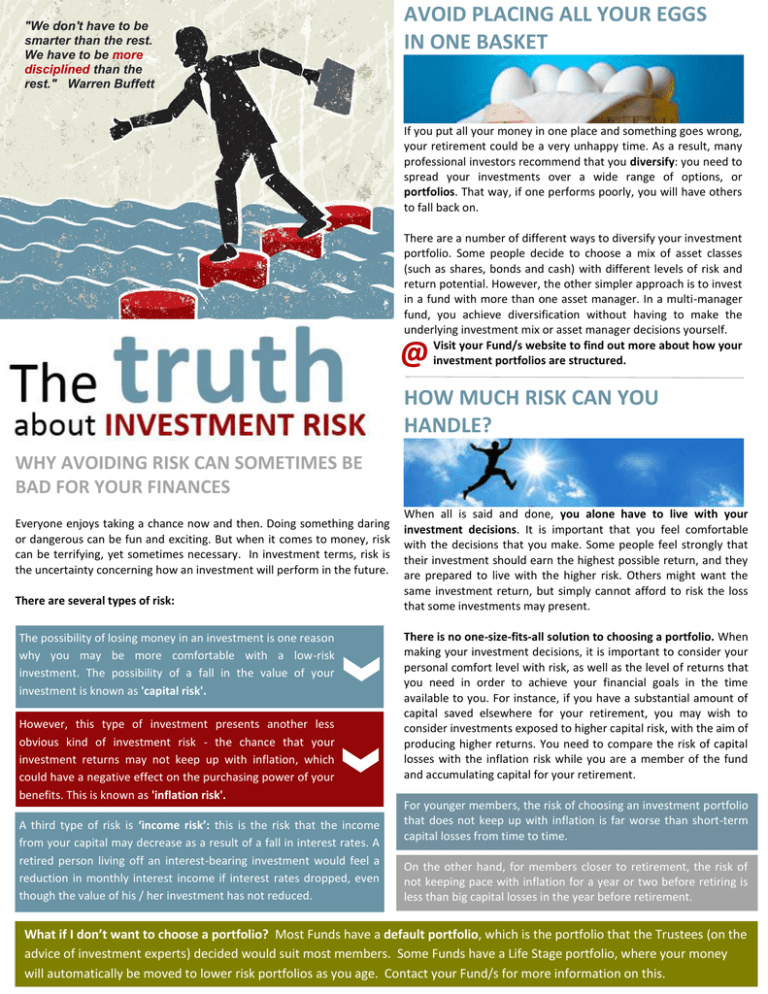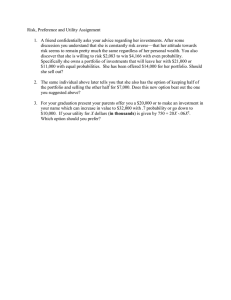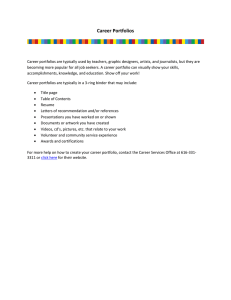AVOID PLACING ALL YOUR EGGS IN ONE BASKET HOW MUCH
advertisement

"We don't have to be smarter than the rest. We have to be more disciplined than the rest." Warren Buffett AVOID PLACING ALL YOUR EGGS IN ONE BASKET If you put all your money in one place and something goes wrong, your retirement could be a very unhappy time. As a result, many professional investors recommend that you diversify: you need to spread your investments over a wide range of options, or portfolios. That way, if one performs poorly, you will have others to fall back on. There are a number of different ways to diversify your investment portfolio. Some people decide to choose a mix of asset classes (such as shares, bonds and cash) with different levels of risk and return potential. However, the other simpler approach is to invest in a fund with more than one asset manager. In a multi-manager fund, you achieve diversification without having to make the underlying investment mix or asset manager decisions yourself. Visit your Fund/s website to find out more about how your investment portfolios are structured. @ HOW MUCH RISK CAN YOU HANDLE? WHY AVOIDING RISK CAN SOMETIMES BE BAD FOR YOUR FINANCES Everyone enjoys taking a chance now and then. Doing something daring or dangerous can be fun and exciting. But when it comes to money, risk can be terrifying, yet sometimes necessary. In investment terms, risk is the uncertainty concerning how an investment will perform in the future. There are several types of risk: The possibility of losing money in an investment is one reason why you may be more comfortable with a low-risk investment. The possibility of a fall in the value of your investment is known as 'capital risk'. However, this type of investment presents another less obvious kind of investment risk - the chance that your investment returns may not keep up with inflation, which could have a negative effect on the purchasing power of your benefits. This is known as 'inflation risk'. A third type of risk is ‘income risk’: this is the risk that the income from your capital may decrease as a result of a fall in interest rates. A retired person living off an interest-bearing investment would feel a reduction in monthly interest income if interest rates dropped, even though the value of his / her investment has not reduced. When all is said and done, you alone have to live with your investment decisions. It is important that you feel comfortable with the decisions that you make. Some people feel strongly that their investment should earn the highest possible return, and they are prepared to live with the higher risk. Others might want the same investment return, but simply cannot afford to risk the loss that some investments may present. There is no one-size-fits-all solution to choosing a portfolio. When making your investment decisions, it is important to consider your personal comfort level with risk, as well as the level of returns that you need in order to achieve your financial goals in the time available to you. For instance, if you have a substantial amount of capital saved elsewhere for your retirement, you may wish to consider investments exposed to higher capital risk, with the aim of producing higher returns. You need to compare the risk of capital losses with the inflation risk while you are a member of the fund and accumulating capital for your retirement. For younger members, the risk of choosing an investment portfolio that does not keep up with inflation is far worse than short-term capital losses from time to time. On the other hand, for members closer to retirement, the risk of not keeping pace with inflation for a year or two before retiring is less than big capital losses in the year before retirement. What if I don’t want to choose a portfolio? Most Funds have a default portfolio, which is the portfolio that the Trustees (on the advice of investment experts) decided would suit most members. Some Funds have a Life Stage portfolio, where your money will automatically be moved to lower risk portfolios as you age. Contact your Fund/s for more information on this.



